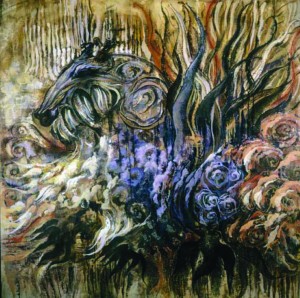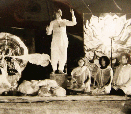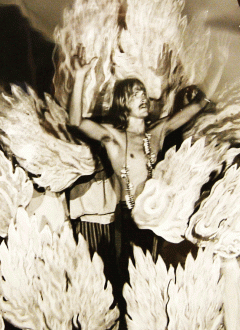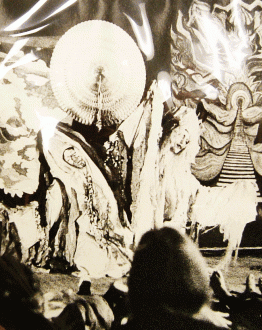Floating Lotus from Ariel Parkinson’s Memoir
ARIEL PARKINSON
Ariel Parkinson, painter, set and costume designer, mesmerizing raconteur (by the delicious loquaciousness of her memoir). I knew her mostly as the wife of Professor Thomas Parkinson, poet, teacher at UC Berkeley in the 60s when I attended for two years — friend of the Beat poets, and writer of one of the first books on the Beat Movement (A Casebook on the Beat), renowned Yeats scholar, and friend and mentor, though he never was professor for any of my UC classes. He also wrote a very positive review of our Opera that appeared in the Daily Californian.
This chapter from Ariel’s memoir recounts a highly imagined and even sometimes fantastic memory of her experience, with some factual stretchings, but catches the essential atmosphere and spirit, which had a distinct similarity to her own paintngs…
Berkeley had had its first great simmering in the mid-forties, strong and vibrant enough to carry along into the 1950s and 1960s a small but dedicated and ever-growing battalion of crazy genius to a Life in Art. Daniel Moore was a student at U.C. Berkeley in the early 1960s, and eventually had two books of poetry published by City Lights. In the minds and lives of those who saw his single marvelous theatrical production in John Hinkel Park, Daniel Moore remains a towering eminence.
Daniel’s aspirations were not modest. His stage directions:
Tribal music. Drama to cut through to the other world,
domain of all possibility
The mountains of heaven ring when word and music,
action and intention and reverberation
work precisely together—
space falls open constantly
shifting stair patterns of
atmospheres and color textures,
wombs for words and actions to be born out of—
eruptions and flows of sound-feeling:
Flute flashes in the smoldering dark…
More specifically, Moore prescribes:
The whole vision is designed to be performed outside in the raw air of IT
on a hillside after civilizations blow all their plugs,
and still the spirit dances, approachable and manifestable
within us…
The manifestation of Daniel’s vision became one of the more fantastic theater pieces of the time.
Berkeley did not have a regular theater until the Zellerbach family provided three at a blow in the late 1960s, but it had the university’s stately Wheeler Hall, with coffered ceiling, street life and plaza life, an alluring City Hall, an assortment of parks, and, crowning glory, a generously scaled Greek Theatre with all its parts. Berkeley’s parks were Park Parks with great lawns, parks heavy with trees and opening into flower beds. Parks articulated by retaining walls, steps, miscellaneous infrastructure of native stone produced expertly and tastefully by Roosevelt’s WPA with an admixture of recent European craftsmen.
John Hinkel Park, a natural amphitheater nestled in the north Berkeley Hills, is one of them. The surrounding grove of huge, graceful live oak, bay, and redwood opens to a tamped clay circle for a stage, and rises in stone tiers for seating on the facing hill. Daniel’s theater.
Who knows what was guiding Daniel. He took advantage of a retired cement magnate who had built a dazzling and enormous (concrete) palazzo for his young bride in an extensive grove about a half mile away from Hinkel Park. At the palazzo, the cypress trees were still saplings, and sculptural animation of the ponds and fountains had barely begun when the bride took off, her husband in pursuit. In return for guarding the estate and certain limited custodial duties, Daniel had several outbuildings to live in and any place he chose for rehearsal. In my years of caring for young babies, well before Daniel, I used to visit the palazzo and its park with baby, buggy, dog, and lunch to admire the spacious terraces and curving staircases, complete with balustrades and pilasters, to watch butterflies, to stare into the dry pools strewn with weeds, and to admire the occasional remnants of cavorting plaster satyrs or nymphs. A few birds, no mammals. Once a thriving colony of honeybees built a great system of combs between two balusters.
Sometime in the mid-sixties this place was the gestation and rehearsal site for Daniel’s Floating Lotus Magic Opera Company. From his 1967 play The Walls are Running Blood come these lines:
From this glass house of earth I have made my journey
On crystalline backs of a trillion existences
Out from the burning hoops at the end of these eyes
where ancient signs revolve in wheels of space
That was the vision. As for dramaturgy, his libretto suggested: “Words riding tones, eruptions and flows of sound-feeling ignited from ritual acts—the music curling around them, piercing through, anticipating, rivering along….” And of infrastructure, from the construction of an artifact to the construction of a meal, Moore wrote: “Our thirst for the primordial keeps us from using electricity to amplify any of the instruments or actors.”
The staging: Fat candles, flares on stanchions, reed pipes, conch shells blaring gloomily, along with a didgeridoo, every kind of low-tech tympani—all established a feast, both visual and auditory.
But first, in this fortuitous union of Life and Art, the Meal: Shortly before opening night, Thomas and I were invited to share the company’s evening meal at its living quarters in the concrete baron’s park. After a generous period of thirty or forty people milling about, imbibing the usual half-gallons of good red wine from up the road in Napa, we sat down in one of three circles in the central rooms. Places were marked by a thin rug or mat, a tiny bowl, and chopsticks. Much scuffling ensued over the effect on the circle of Tom’s extremely long legs, both on the circle and on Tom. He was finally granted the unique privilege of a minimalist chair.
The meal began with linking hands and the sustained, sonorous emission of what may be the most innately powerful single syllable in all human vocabulary: “OUUUMM.” After the initial wide-mouthed intake of breath, release of the vowel sound begins near the upper reaches of thesmall intestine and swells upward. It is succeeded, and finally terminated, by protracted emission of the consonant through gently quivering closed lips—in this case, on the very threshold of the meal, expectantly quivering closed lips. Ceremonies of engagement included repeated choral enunciation of a sacred name or names, holding hands at intervals, and a few helpful glosses or interpolations by our leader. I guess they were helpful; they were in Sanskrit and lasted a very long time.
At last three servers appeared and made the rounds, ladling an excellent lentil soup fleckedwith carrot into the tiny bowls. I cannot recall a lentil soup so fragrant, so entrancing in color,so comforting as it slithered down, retracing in reverse the upward trajectory of OUUUM. An inescapable and protracted invocation of the world spirit is an excellent appetizer. There were no seconds of soup. Succeeding courses were heavy on carbohydrates with mysterious antecedents, no vegetables, and very little sauce, but the company with one accord had moved back to the kitchen and the Party: bread, wine, cake. The era of health food and hollow-eyed youth disbursing it, and the cult that followed of the slow and exquisite, had not yet arrived.
The cosmic ethic that resulted in austerity at mealtime produced voluptuous theater.
A single candle can light a room or a cathedral; in this case, a dozen fat candles placed on the ground define a stage. At first, the flame produces a tiny pool of light against deep shadow. As burning continues, this shadow resolves into a golden haze, cumulatively and spatially in excess of illumination by the single, central, clearly visible cone. Perhaps the melting staff of the candle releases a huge (relative to its size) aura of microscopic particles heated to incandescence. (Something analogous may happen in “natural” sound.) The sculptural quality of objects near the flame is enhanced by golden edges and a margin of black. At the outer areas, where the aura thins, black merges into shadow. The shadow extends and grows, connecting without interruption from theater, to grove, to the vast recesses of the sky; in the absence of volume or of mass, a vast continuum. The secret of candlelight outdoors is to place You in the universe, You and IT , just as Daniel prescribed for his performances: “outside in the raw air of IT.”
Two large conch shells provided basic “flows of sound,” along with percussion, expert and inventive, “chanting, tonal singing/words riding tones.”
The context—sky, grove, the echo of the ocean, flesh—begat the narrative; the narrative, the action. The narrative was about the pandemic mystery of the Middle East, the incarnation of deity and a dying, reborn god. The particular form of the dying god seems closest to Zoroaster. A central figure—light, grace, Mazda—opposed a nearly equal power of evil, Ahriman, but was not entirely free from evil himself. Daniel played both parts.
With his long-limbed, delicate white face, Daniel was a mass of dark waving hair, flashing eyes and arms, fingers extended by long, murderous curved nails. He was Mazda, Fighter and Lover—there was a girl somewhere on the stage—as was the lurking Ahriman. Daniel bounded over the stage to the pulsing beats and the pipes, like Zephyr, brandishing a sword and dressed in dark, exotic silks cut loose to slip away from the body, shimmer over it, like “words flowing over sound,” Zephyr with earrings, huge silver hoops.
He had Magic Powers, one of which was to appear and disappear at will, and make others do the same. The mechanism, as in the ferocious fingernails, was superbly visible, an effective theater stock- in-trade and like many of the old sure tricks, discarded by the graduates of Yale and Carnegie Mellon as too stock-in-trade. Choral stagehands held up a silken cloth rich with embroidery and appliqué in blue, green, and metallic thread, a microcosmic image of the web-of-life in center stage. With a wave of Mazda’s long hand, the enemy was “disappeared” before our very eyes.
The same trick worked for Mazda’s escapes; he became identical to the beauty and the power of the worked cloth. Victim and hero melted into something from which they were, quite plausibly, reconstituted. The same trick worked for visible and invisible. Off-stage is a forgotten territory, irrelevant. But what takes place behind that cloth is teasing, both present and unreachable. What is taking place? With the beautiful cloth, as with the shadow from candlelight, the player merges into something present and so near we can almost touch it, and yet infinitely distant, it is not an absence.
I seem to remember other bits and lengths of dyed and painted silk as magical, drawn and shaken rhythmically across the stage as water, dropped from above or hurled aloft as fog or wind—nature magic, magic you can touch.
The story was not complicated. There were fights and triumphs, and something like an erotic resolution, more or less chastely rendered (plenty of silk again); and one of a handful of great climaxes in theater, world class. Freshly using a movement pattern that had been repeated, literally, hundreds of billions of times, The Floating Lotus Magic Opera that night got it right. In spite of Mazda’s strenuous activity, there was a murder. God was Dead, “A-I, A-I!” The same lament from ancient Egypt, from 5th-century Greece, from the inspired ceremony of the Host: This is my body; this my blood. Eat me. I live. I live in you.
There was a murder. Light, Grace, Good, God, all dead. And yet I live. I live in You.
Chanting, percussion, the groaning, strident conches. A body lying on a stretcher was brought slowly across the stage and carried, swathed in homespun, slowly, mournfully toward the downstage rim. The penitents, as they had for thousands of years, mourned for the god that they had killed. Suddenly, a melee erupted. The penitents ripped open and flung aside the clothing, leapt once more upon the body, tore it apart. They threw the limbs, the head, the hunks of torso into the astonished audience, where it was caught, where it was eaten. This bread, still warm, my body. Red wine was passed around in flagons. This my blood.
At that point actor and audience were indistinguishable, as were stage and the surroundingtiers of seats, the patch of black sky above and the universe beyond. The audience had assisted in the transmission of life through death, in the tiny as in the great, in the cruel love that moves the sun and the other stars. As Yeats asked, “Where but in custom and in ceremony are innocence and beauty born?” Awe, astonishment, elation, joy.
If eight or nine hundred people saw The Floating Lotus Magic Opera, that is a lot. Daniel’s vision was difficult for most people to stomach, his critique of this bloated, exploded planet and what transformation requires. Daniel had valuable ideas, poetic and philosophical, to express the age in a powerful way. Building a culture requires building a world of Imagination and Vision: as solid and comely as the Opera House, as elegant as the Palace Hotel, as spacious and radiant as mists playing catch-up with the sun over the Golden Gate. The Floating Lotus Magic Opera existed. It exists.
I took Daniel’s magic with me.
The paintings here are by Ariel Parkinson, from her memoir, Ariel, by permission from the artist. They have nothing to do with the Floating Lotus art itself. She never designed sets or costumes for us, but are here to show her work, and her imaginative resonance with the Floating Lotus vision. She exaggerates many aspects of my performance in this piece.)










